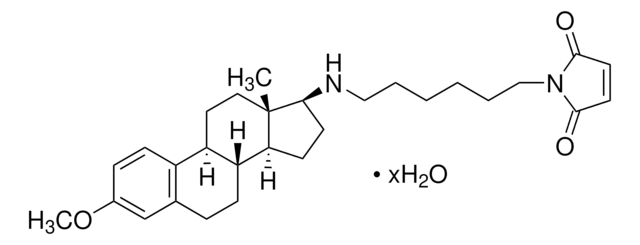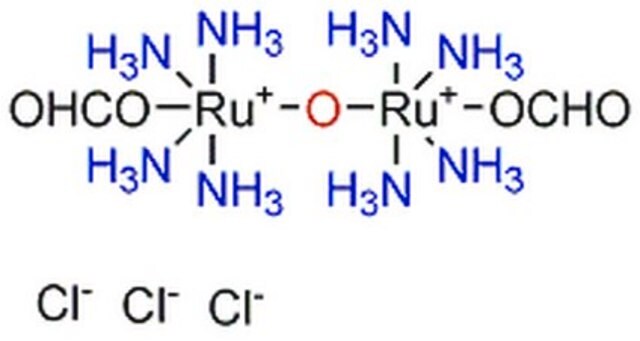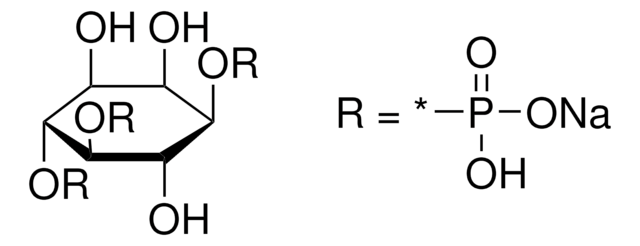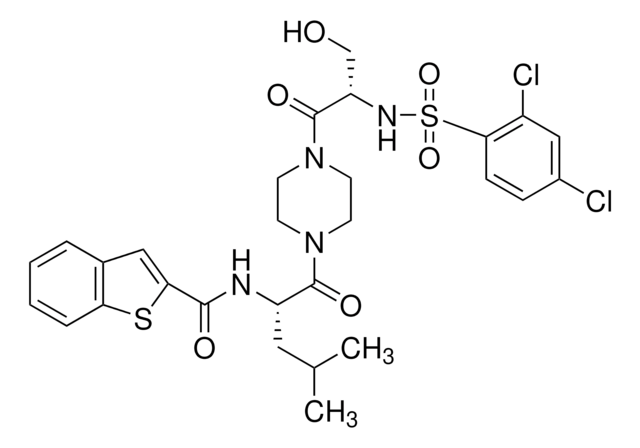100065
2-APB
≥97% (titration), crystalline solid, Ins(1,4,5)P3-induced Ca2+ release inhibitor, Calbiochem®
Sinónimos:
2-APB, 2-Aminoethoxydiphenylborate, (2-Aminoethoxy)diphenylborane
About This Item
Productos recomendados
product name
2-APB, A cell-permeable modulator of Ins(1,4,5)P3-induced Ca2+ release.
Nivel de calidad
Análisis
≥97% (titration)
formulario
crystalline solid
fabricante / nombre comercial
Calbiochem®
condiciones de almacenamiento
OK to freeze
desiccated (hygroscopic)
color
white
solubilidad
DMSO: 20 mg/mL
95% ethanol: 25 mg/mL
Condiciones de envío
ambient
temp. de almacenamiento
2-8°C
InChI
1S/C14H16BNO/c16-11-12-17-15(13-7-3-1-4-8-13)14-9-5-2-6-10-14/h1-10H,11-12,16H2
Clave InChI
BLZVCIGGICSWIG-UHFFFAOYSA-N
Descripción general
Acciones bioquímicas o fisiológicas
Ins(1,4,5)P3-induced Ca2+ release
Envase
Advertencia
Reconstitución
Otras notas
Gregory, R.B., et al. 2001. Biochem. J.354, 285.
Ma, H.T., et al. 2001. J. Biol. Chem.276, 18888.
Ascher-Landsberg, S., et al. 1999. Biochem. Biophys. Res. Commun.264, 979.
Maruyama, T., et al. 1997. J. Biochem.122, 498.
Información legal
Palabra de señalización
Warning
Frases de peligro
Consejos de prudencia
Clasificaciones de peligro
Eye Irrit. 2 - Skin Irrit. 2 - STOT SE 3
Órganos de actuación
Respiratory system
Código de clase de almacenamiento
11 - Combustible Solids
Clase de riesgo para el agua (WGK)
WGK 3
Punto de inflamabilidad (°F)
Not applicable
Punto de inflamabilidad (°C)
Not applicable
Certificados de análisis (COA)
Busque Certificados de análisis (COA) introduciendo el número de lote del producto. Los números de lote se encuentran en la etiqueta del producto después de las palabras «Lot» o «Batch»
¿Ya tiene este producto?
Encuentre la documentación para los productos que ha comprado recientemente en la Biblioteca de documentos.
Los clientes también vieron
Nuestro equipo de científicos tiene experiencia en todas las áreas de investigación: Ciencias de la vida, Ciencia de los materiales, Síntesis química, Cromatografía, Analítica y muchas otras.
Póngase en contacto con el Servicio técnico
















